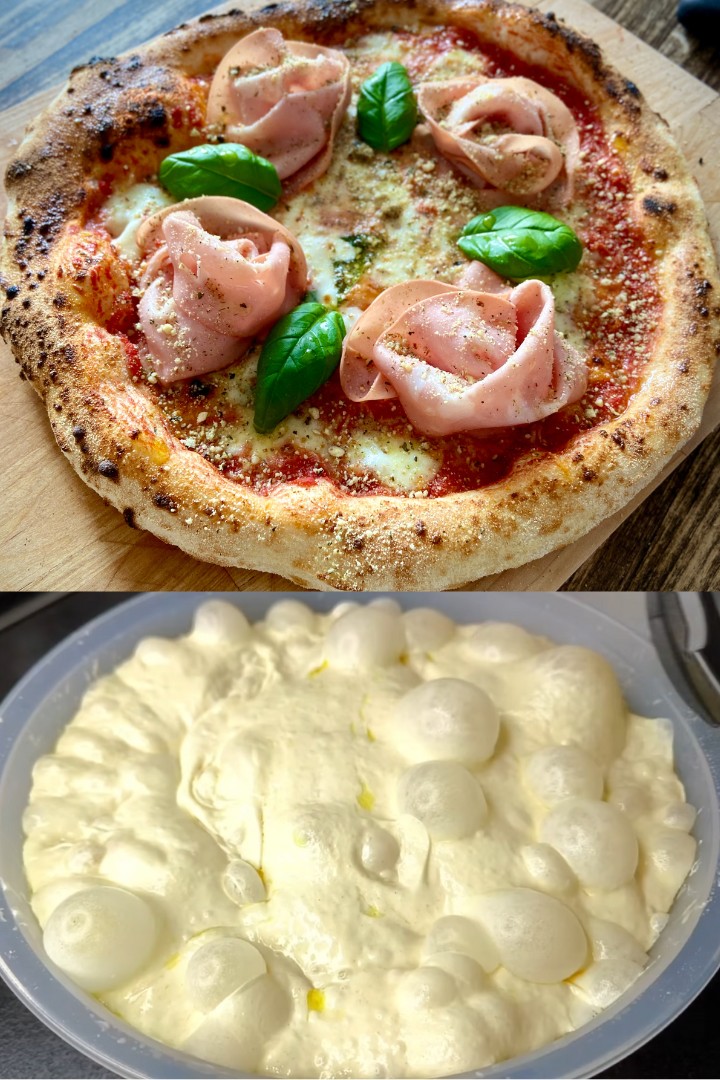ADVERTISEMENT
Instructions:
1. Activate the Yeast:
In a small bowl, combine the warm water and sugar. Stir until the sugar is dissolved. Sprinkle the active dry yeast over the water and let it sit for 5-10 minutes, until it becomes frothy. If the mixture doesn’t foam, your yeast might be expired or the water temperature might have been too hot or too cold, so start again.
2. Mix the Dough:
In a large mixing bowl, combine the flour, salt, and garlic powder (if using). Make a well in the center and pour in the activated yeast mixture along with the olive oil. Stir with a wooden spoon or dough hook until the dough begins to come together.
3. Knead the Dough:
Turn the dough out onto a lightly floured surface and knead it for about 8-10 minutes, until it becomes smooth and elastic. If the dough is too sticky, add a little more flour—just a tablespoon at a time—until it reaches the right consistency. If it’s too dry, add a tiny bit more water.
4. Let It Rise:
Place the kneaded dough in a lightly oiled bowl, turning it once to coat the surface in oil. Cover the bowl with a clean kitchen towel or plastic wrap and let it rise in a warm spot for 1 to 1.5 hours, or until it doubles in size. If you’re short on time, you can use the dough after about 30 minutes of rising, though a longer rise will give it better flavor and texture.
5. Preheat the Oven:
While the dough rises, preheat your oven to 475°F (245°C). If you have a pizza stone, place it in the oven while it’s heating for an even crispier crust.
6. Shape the Dough:
Once the dough has risen, punch it down to release any air bubbles. Divide the dough into two portions if you want two medium-sized pizzas, or leave it whole for one large pizza. Roll out the dough on a floured surface until it reaches your desired thickness. For a thinner crust, roll it out more; for a thicker crust, roll it out less.
7. Add Your Toppings:
Transfer your rolled-out dough to a pizza peel or a baking sheet lined with parchment paper. Add your favorite pizza sauce, cheese, and toppings. You can keep it classic with mozzarella and basil, or get creative with pepperoni, veggies, and even specialty cheeses like goat cheese or ricotta.
8. Bake the Pizza:
Place your pizza in the preheated oven and bake for 12-15 minutes, or until the crust is golden brown and the cheese is bubbly and slightly browned. If using a pizza stone, the pizza will cook faster, so keep an eye on it and adjust the time accordingly.
9. Enjoy:
Once baked, remove the pizza from the oven and let it cool for a few minutes before slicing. Serve with a drizzle of olive oil or a sprinkle of fresh herbs for an extra touch of flavor.
Tips for the Best Pizza Dough:
- Use Room Temperature Water: Water that’s too hot will kill the yeast, and water that’s too cold will prevent it from activating. Aim for water that’s comfortably warm to the touch.
- Let the Dough Rise Slowly: For the best flavor and texture, allow the dough to rise in a warm spot for at least an hour. For even better results, you can let it rise overnight in the fridge, which will develop more flavor.
- Don’t Overload on Toppings: Keep your toppings balanced. Too many toppings can make the pizza soggy and prevent the crust from cooking properly.
- Experiment with Flour: For a chewier, more authentic pizzeria crust, you can swap out a portion of the all-purpose flour for bread flour or even 00 flour (a finely milled Italian flour).
Why This Recipe Works:
- Simple and Reliable: This dough recipe is straightforward, using common ingredients you likely already have in your pantry. With just a little attention to detail, you’ll have a pizza dough that’s soft, light, and perfect for holding any topping.
- Pizzeria Quality: The dough mimics the texture and flavor of the dough from a traditional pizzeria, with a slight chewiness and golden, crisp edges that are the hallmark of a great pizza.
- Customizable: The recipe is versatile enough for you to customize it for your taste, whether you prefer a thin, crispy crust or a thick, doughy base.
Final Thoughts:
Making homemade pizza is easier than you might think, and with this recipe for soft and light pizza dough, you can enjoy a pizzeria-quality meal in the comfort of your own home. Whether you’re planning a pizza night with family or a solo treat, this dough provides the perfect foundation for any topping you can dream of. So next time you’re in the mood for pizza, skip the delivery and give this simple, homemade recipe a try—you’ll be amazed at how delicious and satisfying it is!
ADVERTISEMENT
